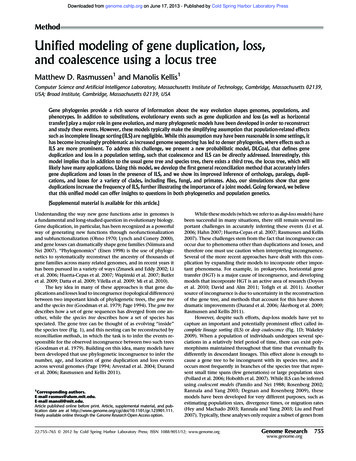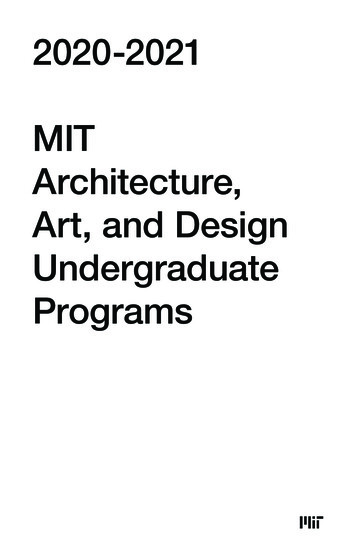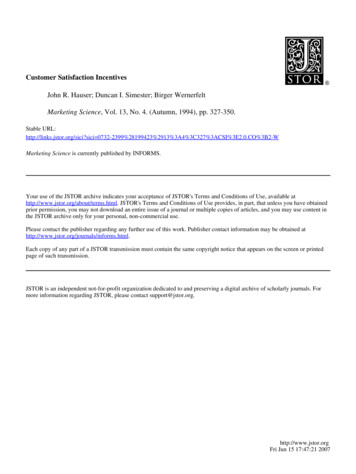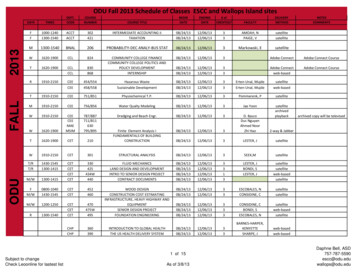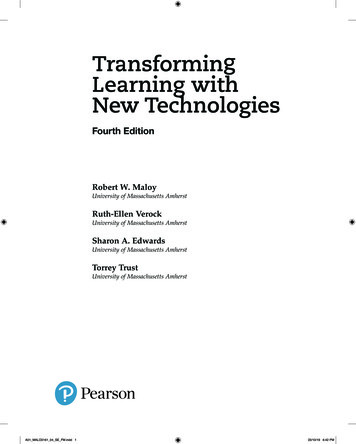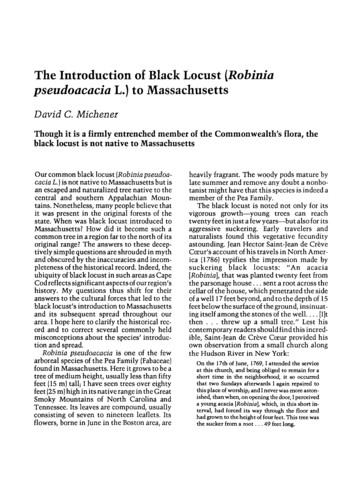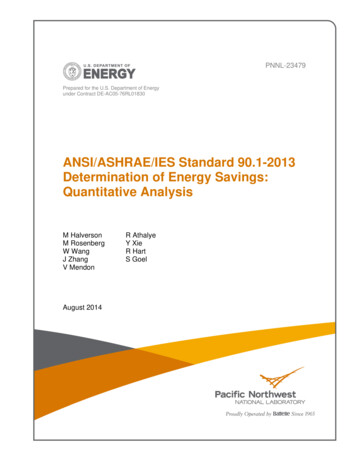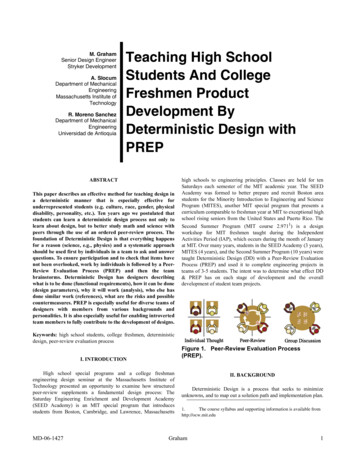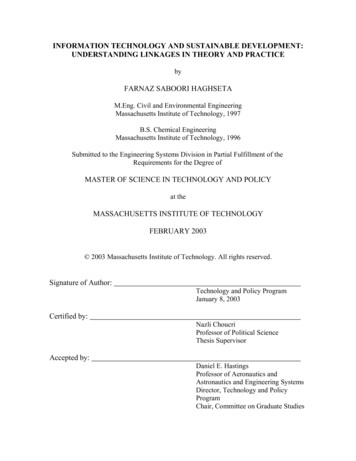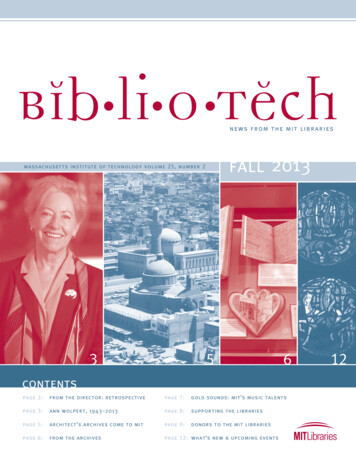
Transcription
news from the mit librariesfall 2013massachusetts institute of technology volume 25, number 2356contentspage 2:from the director: retrospectivepage 7:gold sounds: mit’s music talentspage 3:ann wolpert, 1943–2013page 8:supporting the librariespage 5:architect’s archives come to mitpage 9:donors to the mit librariespage 6:from the archivespage 12: what’s new & upcoming events12
2from the directorfrom the directorOn Wednesday, October 2, 2013 the MIT Libraries lost a great leader, mentor andfriend. Ann Wolpert, Director of Libraries, passed away after a brief illness, at age70. Those who knew Ann, and who read her columns in this space, benefited fromher thoughtful wisdom, engaging wit, and sharp intellect.Ann’s first “From the Director” column appeared in the Spring 1996 issue of whatwas then MIT Libraries’ News. In it she announced that, “MIT and its Librarieswere in for an exciting time The potential of the Internet and World Wide Webto enhance traditional teaching has energized faculty and students—as well aslibrarians.” It was with that energy and enthusiasm that Ann led the MIT Librariesinto the digital future—she faced it head-on, and embraced it.In the spring of 2000, as MIT began a capital campaign, Ann advocated for theexpanded technology needs of MIT’s students and libraries. “What will thelibrary of the future look like at MIT? Certainly, students will still work, andthink, and write, and study in the MIT Libraries. The future will also depend onthe availability of advanced technology, adequate endowments for informationresources, and new and renovated spaces capable of supporting services thatwill change as possibilities and needs evolve,” she wrote.During her tenure Ann was steadfast in advancing the needs of MIT’s students andfaculty—the Libraries became more wired (and now wireless) than ever, and thenumber of electronic resources grew by leaps and bounds. Library spaces evolvedtoo. Renovation projects were completed in the Lewis Music, Dewey, and Barkerlibraries; 24/7 study spaces opened in Hayden, Dewey, and Barker; and the DigitalInstruction Resource Center (DIRC), Geographic Information Systems (GIS) Lab,Wunch Preservation Lab, and Maihaugen Gallery were envisioned and created.“Contemporary information comes in many formats, and contemporary studentsneed study spaces that operate on the same 24-hour a day schedule as the Institutedoes,” she would say.Often it seemed that Ann moved at a 24/7 pace herself, along with the Institute.With this momentum she led the Libraries into new and exciting collaborationswith potential for long-lasting impact. In her Spring 2001 column she announced,“In typical MIT fashion, the MIT Libraries have chosen to tackle important butdifficult research problems, and to work with industry on real problemswhenever possible.”She went on to outline a partnership with Hewlett Packard that would lead to thedevelopment of DSpace, an open-source digital repository to preserve facultyresearch. Ultimately the DSpace platform would become one of the most successfulprograms of its kind, adopted by more than 1,000 institutions worldwide.MIT PressretrospectiveAnn Wolpert, 2012Ann was equally engaged in efforts to change thetraditional model of scholarly publishing. In aclimate of escalating journal prices that challengedall academic libraries, she advocated, along withMIT faculty, for alternatives that would allowgreater access for everyone.In 2009 the MIT Faculty Open Access Policy wasenacted, and in her column she wrote, “When theMIT faculty voted to adopt a policy of open access fortheir peer reviewed research articles, they did so out ofa conviction that knowledge is advanced and learningis encouraged when there is timely, barrier-free accessto new and accumulated knowledge The MITLibaries are honored to host these articles in ouronline repository DSpace@MIT.”Ann would be the first to point out that many of thesuccesses during her tenure were accomplished withthe help of library friends and supporters. As sheremarked in her Fall 2000 column, “Friends, it is said,are like porch pillars. Sometimes you need them tolean on. Sometimes it’s enough to just know they arestanding by.” During this time of transition, we givedeep thanks to you, our friends and supporters, foryour kind words and condolences. We are verygrateful to have you standing by.Co-Interim DirectorsSteve Gass617 253 7058sgass@mit.eduDiane Geraci617 253 5962dgeraci@mit.edu
ann wolpert, 1943-20133ann wolpertdirector of libraries, has died at 70. served mit for 17 years;was leading light on role of the research library in the digital ageRichard HowardNate Nickerson, MIT News,reprinted from October 2, 2013Ann Wolpert, MIT’s director of libraries since 1996, has died after a brief illness.She was 70 years old. Wolpert was a pioneer in digital stewardship, bringing to theMIT community a deep understanding of scholarship, of research, and of the library’sbroader mission to preserve and disseminate knowledge. Under her leadership, theMIT Libraries developed DSpace, a milestone in digital libraries that catalyzed theinstitutional repository movement.Wolpert began work at MIT just as the Internet was emerging, and her tenure wasmarked by her passionate response to the opportunity and upheaval that resulted forresearch libraries. In scientific, research, and university communities around theworld, a debate, still unresolved, came to the fore: how the decades-old system ofpeer-reviewed scholarly journals ought to operate in the digital world.Wolpert became a leading voice in that discussion; she argued for unrestricted onlineaccess to journal articles. In a February 2013 essay in the New England Journal ofMedicine, she not only made the case for such access: She also called it an inevitability.“There is no doubt,” she wrote, “that the public interests vested in funding agencies,universities, libraries, and authors, together with the power and reach of the Internet,have created a compelling and necessary momentum for open access. It won’t be easy,and it won’t be inexpensive, but it is only a matter of time.”Ann Wolpert, 1996, at the startof her career with MIT Libraries“I knew her to be very dedicated to MIT,and she thought carefully about howour library system could best servethe Institute and beyond. She was anexcellent steward of our scholarship —and a very dear colleague. I will missher very much.”– L. Rafael Reif, MIT PresidentThough Wolpert made her case forcefully, she was not dismissive of concerns abouthow open access might work in practice, and she upheld the value of peer review.“The fact,” she wrote, “that faculty members and researchers donate to publishersthe ownership of their research articles—as well as their time and effort as reviewers—does not mean that there are no expenses associated with the production ofhigh-quality publications. For all its known flaws, no one wants to destroypeer-reviewed publication.”Hal Abelson, the Class of 1922 Professor of Computer Science and Engineering atMIT and founding director of both Creative Commons and the Free SoftwareFoundation, remembers Wolpert as “one of the great intellectual leaders at MIT.”She fused, he says, a mix of business experience from her earlier career with seriousacademic curiosity and integrity. “Ann was funny, warm, caring, and remarkably fair,”Abelson says.“She believed in open access, but it went deeper than that,” he adds. “Her centralinsight was that in the age of the Internet, a great research library could serve not onlyas a window into scholarly output for given members of university and researchcommunities, but also as a window for the world at large into the scholarly enterprise.That was a great and thrilling idea, and she pursued it deftly and with great respect forthe full spectrum of faculty views.”
4L. Barry Hetheringtonann wolpertann wolpert, 1943-2013(continued from page 3)MIT President L. Rafael Reif, in hisprevious role as provost, worked closelywith Wolpert. “I knew her to be verydedicated to MIT, and she thoughtcarefully about how our library systemcould best serve the Institute and beyond,”he says. “She was an excellent steward ofour scholarship—and a very dearcolleague. I will miss her very much.”As Director of Libraries, Wolpert managedthe MIT Libraries and the MIT Press. TheMIT Libraries—with five major subjectAnn Wolpert, 2008, speaking at thecollections, the Institute Archives andopening of the Maihaugen GallerySpecial Collections, and a staff of 170—support the research and teaching needs of the Institute community. The MIT Presspublishes around 30 journals and 220 books each year in a wide range of subjects.Wolpert also served on MIT’s Committee on Intellectual Property, the Council onEducational Technology, the OpenCourseWare Faculty Advisory Committee, theDeans’ Group, and Academic Council. She also served as chair of the board ofdirectors of MIT Technology Review. In 2000, Wolpert helped lead the MIT Libraries’collaboration with Hewlett-Packard to build DSpace, an open-source digital archivefor faculty output that has been adopted by more than 1,000 institutions worldwide.In 2009, Wolpert was instrumental in the conception and passage of the MIT FacultyOpen Access Policy, whereby faculty authors give MIT nonexclusive permission todisseminate their journal articles for open access through DSpace@MIT. It was thefirst institution-wide policy of its kind in the United States. Open sharing of MITscholarship has given readers around the world access to the results of MIT’s research.Wolpert continued to be a player in other “startups” that have the potential totransform the way research institutions and their libraries collaborate to solveproblems big enough to call for a collective response. She referred to these as “solutionsat scale.” Among them is the Digital Preservation Network (DPN), to whose inauguralboard she was recently appointed. DPN was created to ensure that the scholarly recordis preserved for future generations by using a shared, national preservation ecosystemcomposed of several federated, replicating nodes containing redundant copies of alldeposits to protect against catastrophic loss.Wolpert was a leader in her field. “Ann has been a trailblazer in defining the new rolesof libraries in an era of data-intensive scholarship,” says Cliff Lynch, executive directorof the Coalition for Networked Information. “Her work in the development ofinstitutional repositories as a means of curating and making public the researchcontributions of universities has fundamentally reshaped strategies for managingscholarship at a national and international level. She will be greatly missed.”Prior to joining MIT, Wolpert was executive director oflibrary and information services at the Harvard BusinessSchool. Her experience previous to Harvard includedmanagement of the information center of Arthur D.Little, Inc., an international management and consultingfirm, where she also worked on various consultingassignments. More recent consulting assignments tookher to the University of New Mexico, Cornell Universityand Adelphi University in New York, the campuses ofINCAE in Costa Rica and Nicaragua, MASDAR inAbu Dhabi, the League of European Research Librariesin Amsterdam, the National Library of China, and theMalaysia University of Science and Technology.In 2005 Wolpert served as president of the Associationof Research Libraries and was most recently a memberof its Influencing Public Policies Steering Committee.She served on the boards of directors of the BostonLibrary Consortium, the National Academies’ Boardof Research Data and Information (BRDI), DuraSpace,and DPN, and on the steering committee of theCoalition for Networked Information. She alsoserved as a publications advisor to the MassachusettsMedical Society.Wolpert received a BA from Boston University andan MLS from Simmons College, where she was anhonorary trustee and a member of the board of advisorsof the PhD Program in Managerial Leadership in theInformation Professions at the Graduate School ofLibrary and Information Science.Wolpert is survived by her husband, Samuel A. Otis Jr.,and a large extended family.Gifts in memory of Ann Wolpert may be made toMIT for the Ann J. Wolpert Strategic Initiatives Fund(3933810) to support the MIT Libraries. ContactBonny Kellermann ‘72, Director of Memorial Gifts,at bonnyk@mit.edu, for details.An MIT memorial service is planned for January 31,2014 at 3:00 p.m; in Building 10-250. The service willbe open to the academic and professional communityboth locally and nationally.
architect’s archives5architect’s archivesdistinguished iraqi architect’s archives come to mitThe Aga Khan Documentation Center at the MIT Libraries(AKDC@MIT) has become a repository for select personal archivesof architects working in the Middle East. The first architect archiveacquired by the AKDC@MIT arrived in the summer of 2012 as agift from the distinguished Iraqi architect and urban planner,Mohamed Saleh Makiya.Makiya’s generous gift to the AKDC@MIT documents hisprodigious career, spanning five decades and work in over one dozencountries. The vast archive contains materials ranging from personalcorrespondence, project notes, and hand drawn design sketches, toformal proposals, final drawings, and photographs for projects builtand unbuilt.Mohamed Makiya (1914 – ) was born in Baghdad and educated inEngland, receiving his Bachelor of Architecture at Liverpool Schoolof Architecture and a diploma in civic planning from LiverpoolUniversity in 1941 and 1942, respectively. He completed his PhDin 1946 at Kings College, Cambridge, and returned to Baghdad thatsame year to establish Makiya Associates, an architectural andplanning consultancy practice.During the 1950s he designed houses and commercial buildings andbecame increasingly aware of the heritage of Iraqi architecture. Makiyawas one of the original founders of the Department of Architecture atAerial view of Khulafa MosqueMohamed Saleh Makiyawhat is the aga khandocumentation center?Situated within the MIT Libraries, the AKDC@MIT, a part of the Aga KhanProgram for Islamic Architecture (AKPIA) at MIT and Harvard, was establishedin 1979 by a gift from His Highness the Aga Khan. The Center supportsteaching of, and research on, the history and theory of architecture,urbanism, environmental and landscape design, visual culture, andconservation, as well as the practice of architecture, in Muslim societies.the College of Engineering, Baghdad University, in 1959, and servedas its head until 1968. During subsequent years, Makiya Associatesoffices were established in Bahrain, Oman, London, Kuwait, Doha,Abu Dhabi, and Dubai.The work and ideas of Mohamed Makiya and his firm have beeninvestigated in numerous books and articles, and examined andexplored in conferences and exhibitions, including an internationalconference on Baghdad architectural heritage held earlier this year atthe University of Baghdad. The conference was part of the events of“Baghdad, Arab Capital of Culture for the Year 2013,” sponsoredthrough a partnership between the University of Baghdad, Ifpo (theFrench Institute of the Near East), and the UNESCO Office for Iraq.Makiya’s contributions to the fields of architecture and urbanism and,in particular, his sophisticated incorporation of traditional forms intomodern architecture, cannot be overstated.The Mohamed Makiya Archive was highlighted at the MIT Librariesthis past summer when the first important commission of Makiya’scareer, the Khulafa Mosque (1960–1963; proposed extension, 1980),was presented as part of the larger Rotch Library exhibition, Learningwith Visual Architecture Collections: Highlights from Rotch DigitalCollections. “Mohamed Makiya and the Khulafa Mosque Project(s)”included 25 images of sketches, design notes, plans, and photographsreproduced from originals held in the archive. The images told thestory of this monumental project that developed around the onlyremaining artifact of the ninth-century Abbasid mosque onceoccupying the space: the dilapidated minaret of al-Ghazl. Makiya’sinnovative design for the mosque, located in the Sabbabigh al-Aalneighborhood of Old Baghdad, embodied ideas of urban conservation,regionalism in form, and continuity of architectural heritage; ideaswhich informed his work henceforth as well as that of youngergenerations of architects.Select projects from the Mohamed Makiya Archive will be available asa digital collection at archnet.org, an international online communityfor architects, planners, urban designers, landscape architects,conservationists, students, and scholars, with a focus on Muslimcultures and civilizations, co-managed by AKDC@MIT and the AgaKhan Trust for Culture in Geneva, Switzerland. The physical archive isavailable to students, faculty, researchers, and scholars in the Center byappointment. See libguides.mit.edu/islam-arch for more information.Sharon C. Smith, Ph.D.Program Head, Aga Khan Documentation Center at MIT617 324 5022scsmith@mit.edu
46from the archivesfrom the archivesphotos by L. Barry Hetheringtonhelping to bring special collections to lightMaihaugen GalleryItems in the exhibit “Noteworthy Connections:Music in the MIT Libraries”In recent years, the generous support of donors has helped us increase the visibilityof the MIT Libraries’ special collections, making the past come alive.The Maihaugen Gallery, funded by an anonymous donor and the family of GaryGregory (Class of 1973), has allowed us to showcase our treasures through numerousexhibitions. Since it first opened in 2008, over 10,000 guests have toured theexhibits. The creation of the gallery literally opened a window into our archivesand special collections.A gift from Thomas F. Peterson, Jr. (Class of 1957) enabled us to conserve and catalogthe Vail Rare Book collection. The collection of over 15,000 items is now fullysearchable online though the Barton catalog. The project uncovered many historicalgems, and allowed us to more easily discover and share these amazing materials inthe classroom, where they give students a unique hands-on educational experience,and bring a sense of wonderment.Generous donations from Lionel Kinney (Class of 1953) supported the Music@MITOral History Project, resulting in a wonderful collection of oral histories, which wererecently made available on the Libraries’ website (read more about the project on page 7).Additional funding from the Kinney gift is being used for a Music@MIT Digital AudioInitiative, providing for the digital reformatting of decaying analog materials, enablingproper preservation, and better access.New donor funding is also helping with the processing of two recently acquiredarchival collections, the Herb Pomeroy Jazz Collection and the Jordan BaruchPapers. Pomeroy was a noted jazz trumpeter and former leader of the MIT JazzEnsemble. Baruch was an acoustical engineer who worked at Bolt, Beranek andNewman (BBN), taught at MIT, and was U.S. Assistant Secretary of Commerceduring the Carter administration.Professor Michael Cuthbert speaking at theopening of “Noteworthy Connections”Organizing and describingarchival materials (or “processing”materials) is a labor-intensive activity,but a necessary one—without thisstep archival collections are extremelydifficult to navigate and mine.Once processed, these collectionsare more useful and effective forscholarly research.Thanks to the generous support of donors, the specialcollections mentioned above are now accessible wellbeyond the Libraries’ walls. But with over 20,000,000items in the Institute Archives and Special Collections,there are still only a fraction of our collections that areappropriately accessible, and many remain “hidden.”Gifts to the Institute Archives and Special CollectionsFund (Archives Collection Fund 2780500) will helpus continue to bring these valuable collections to light.Tom RoskoInstitute Archivist and Head,Institute Archives & Special Collections617 253 5688rosko@mit.edu
7gold sounds: mit’s music talentsgold soundsmit’s music talents contribute to a new oral history“Music has been animportant part of MITsince its creation,” saysPeter Munstedt, LewisMusic Librarian. “Goingback to the 19th century,it’s always been anintegral part of life here.”From the MIT Alumni Association’s Slice of MIT“I never have said this to the students, and you maywant to edit this out,” John Corley said in a 1999interview with the Lewis Music Library’s ForrestLarson, “but I’ll characterize MIT and music: there’sno substitute for brains, you know. We’re able to dothings at MIT that I couldn’t do at a conservatory.”Such notes of wisdom emerge when one enters the newvirtual space, libraries.mit.edu/music-oral-history,of the MIT Music Oral History Project. Catalogingover a decade of interviews, this audio and videoarchive of nearly 50 notable interviews has been madeavailable to the public for the first time.Corley, who founded the MIT Concert Band in 1949,chats for nearly six hours on tape with Larson, relatingcolorful tales of students, field trips, concerts, andfans in the half-century of his tenure. But Corley’sinterview is only one such gem in the collection, aneffort made possible by a gift from Lionel ’53 andVilma Kinney which is housed in MIT’s LewisMusic Library.The archive includes interviews with professors,visiting artists, department heads, conductors, andTechtonians–students who played all manner ofinstruments, from violin to trumpet to electronica.Nearly 50 interviews are now available online at:libraries.mit.edu/music-oral-historyLarson, who is the circulation and reserves associate at Lewis, discovered that hisinterview subjects were not just telling the story of music at MIT, but the history ofmusic in the world. In frank and lengthy conversations with his subjects, Larson waspleased to hear his subjects cover “more than just their love of music. What it showsyou is the culture of MIT and the students who come out of that the fact thatthey’re often not one-track minded people, but have a broad interest in things.”Each interviewee is as intriguing as the next. Herb Pomeroy, the first director of MITJazz Bands and founder of the MIT Festival Jazz Ensemble, recalls his recruitment tothe Institute in a candid moment.“So the phone rang I answered it. He said, ‘I’m Klaus Liepmann, Director of Musicat MIT. We have a band here at MIT that is so bad,’ he said, ‘that I’ve told them todisband. Or if they—if they want to continue, do not use the name MIT to beassociated with.’”Thankfully, they did not disband. Pomeroy, then a Berklee professor, took up thecause, and brought great distinction to the jazz scene on the north side of the Charles.Scholars have already used the project as a starting or continuing point for other kindsof research, most frequently about the collection’s influential figures. But Larson sayshe looks forward to helping others discover uses for it in the years to come.Joe McGonegalCommunications Specialist, MIT Alumni Associationjmcg@mit.eduProfessor Emeritus of Music Barry Vercoe
8supporting the librariesupcoming exhibitssupporting the librariesdambrogio named as libraries’thomas f. peterson (1957) conservatorJana Dambrogio has joined the MIT Libraries as the new Thomas F. Peterson (1957)Conservator. In this role she manages MIT’s special collections conservationprogram–planning and executing conservation treatments for the physicalmaintenance of rare books, archives, and manuscripts. She also contributes tothe Libraries’ overall preservation strategy.Dambrogio comes from the National Archives and Records Administration (NARA)where she was a senior conservator since 2004. In addition to her work at NARA,she brings an impressive array of experience from consultancies, fellowships, andinternships at other well-known national and international institutions such as theFood and Agriculture Organization (FAO) of the UN, the Vatican Secret Archives,the Folger Shakespeare Library, and the Houghton Library at Harvard University.“Jana is an experienced and innovative conservator who brings a high level ofcommitment, notable ability, and passion for conservation that we have beenfortunate to have in this position,” said Nancy McGovern, head of curation andpreservation services.Dambrogio fills the role left open after Nancy Schrock retired in February 2013.The conservator position is endowed by generous long-time MIT Libraries’ supporterThomas F. Peterson, Jr. (Class of 1957).Jana DambrogioDuring her first week, Dambrogio hit the groundrunning. She worked with colleagues to quicklyrespond to a flood in an MIT administrative office andsave damaged materials. She also identified Libraries’materials that will be on loan for an exhibit at HistoricNewton. She enjoys this hands-on role.“I’m drawn to the philosophy at the Institute. Learningby doing is important to me. Working with originalmaterials, one can learn so much from how somethingwas made. Artifacts tell a story, they are witnesses tohistory. That’s why preserving them in their originalformat is so important,” Dambrogio says.mit and harvard libraries awarded grantto foster careers in digital stewardshipMIT and Harvard libraries will play a role in ensuring a new generation of libraryschool graduates will be prepared for jobs in digital stewardship. The universities werejointly awarded a 2013 Laura Bush 21st Century Librarian Program Grant for nearly 500,000 from the Institute of Museum and Library Services (IMLS) that will funda pilot program to help recent graduates gain the skills, experience, and networkneeded to begin successful careers.“There’s a real gap between students graduating and the skills they need for availablejobs. The program aims to bridge that gap,” said Nancy McGovern, head of curationand preservation services for MIT Libraries, and a co-author of the grant proposal.The program will mirror a national digital curation residency program developed bythe Library of Congress, but it will be the first of its kind in the Boston-area. Over thecourse of two years a total of ten residents will get hands-on experience in projectsthat involve digital library collections, long-term preservation, and accessibility ofdigital assets. Recent library school graduates will have a chance to apply for theprogram that will give them the opportunity to work with a host institution in theBoston-area, and network with other area institutions, industry leaders, and peers.“It’s an exciting opportunity for theMIT Libraries to participate in raisingawareness, and building communityand competencies in this field,”said McGovern.McGovern will coordinate the development of theprogram’s curriculum, in collaboration with AndreaGoethals, manager of digital preservation andrepository services for Harvard Library, and lead authorof the grant proposal. The first year of the grant willcover planning and preparation. The program willwelcome the first cohort of residents in fall 2014.
9donors to the mit librarieswith appreciation:donors to the mit libraries july 1, 2012 – june 30, 2013We are delighted andgrateful to acknowledge thegenerosity of the followingsupporters of our programsand collections. As donors,you make it possible forthe MIT Libraries and itsstaff to provide the criticalinformation resources andservices that are requiredto support the MITacademic community.We remain committed toserving the needs of ourgreat students and faculty,and we are all deeply andsincerely grateful for yourenthusiasm and support!Co-Interim DirectorsSteve GassDiane Geraci 500,000 Elizabeth J. YeatesRevocable Trust 200,000 – 499,999Lionel & Vilma KinneyA. Neil PappalardoThomas F. Peterson, Jr. 50,000 – 99,999Baruch FundMichael Good & JoAnn CloseRaymie Stata 25,000 – 49,999Paul G. Gregory IIIThomas Stone &Valerie Warrior 10,000 – 24,999Gerald M. AppelsteinBrit J. d’Arbeloff 5,000 – 9,999Young Soo Perry &Dong Joo Karen HaJames & Marianne RothnieBruce RubingerShirley M. Sontheimer 2,500 – 4,999Thomas P. BlackDavid L. desJardinsMarian DeWittGareth & Sandra EatonArnold & Margit OrangeZartarian Foundation 1,000 – 2,499O. Reid & Lisa AsheJudy BasmajianIfigenia A. BoulogianeRichard C. BradtMarjorie C. BrandrissAndrew G. BraunEdwin F. Brush, Jr.E. N. CarabateasRichard T. CockerillPeter D. CookMary Jean CrooksDorothy SageDean G. DuffyThomas G. EvansLinda J. GerberNicholas T. HamiseviczLinda HutchinsThomas S. IngraJacqueline KnowlesAllen S. LeeVirginia S. McCurdyMollusca FundJeffrey Morrow &Sara GaucherPatricia NanianGerald NykolakMary J. O’HearnBarbara K. OstromEnlin PanCatherine ParhamBrandon W. PorterResearchers from KITJohn I. RhoStuart J. RubinWarren & Phyllis SewallLouis E. SlesinVicki T. SmithDavid I. SoloRinaldo A. SpinellaMargie E. StarkAlar ToomreJason WellerDaniel WillardDavid A. WoodruffJennifer Zartarian 500 – 999Andreas S. BommariusJoanne ChengMark S. DayJacqueline J. DesoerBessie K. EconomosGradientPhillip Hartley SmithKenneth G. HellyarConstance A. HerronGerald Z. HertzRoss N. HoffmanMicheline JedreyElisabeth S. KingAlexander KuskoS. Ming LeeFrederick J. LeonbergerDouglas S. LutherPeter D. MatthewsJacek & Krystyna MozdzanowskiWilliam J. NicholsonLauren E. OldjaAlice PierceJudith A. QuillardSteven P. RalstonThomas John RosalankoFrank J. Stefanov-WagnerCharles SteindelPriscilla T. StoyanofTatsuo TashinoMichael L. TavissGlenn E. TaylorDr. William W. ToyMark Y. D. & Sally WangPeter J. WenderDonald G. WickhamContinued on next page* Donors of 1,000 or more aremembers of the MIT Libraries’Director’s Circle
L. Barry Hetheringtondonors to the mit librariesL. Barry Hetherington10Professor Michael Cuthbert, Frank (Ishmael) Stefanov-Wagner, and Peter Munstedt 250 – 499Louis AlexanderSunny Y. AuyangL. Stephen BraceWilliam & Meeho ChinCisco FoundationJulie CohnG. Doyle Dawwves, Jr.Amy Davidson PlummerMargaret dePopoloTracy A. EmbreeRolf GoetzeLeon B. GroisserJSRM FoundationMr. Alan E. KruseCharles H. LawranceEarl E. LazersonLeonard LevinR. A
directors of MIT Technology Review. In 2000, Wolpert helped lead the MIT Libraries’ collaboration with Hewlett-Packard to build DSpace, an open-source digital archive for faculty output that has been adopted by more than 1,000 institutions worldwide. In 2009, Wolpert was instrumental in the c
